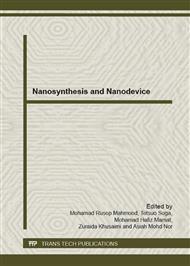[1]
F.S. -S. Chien, C. -R. Wang, Y. -L. Chan, H. -L. Lin, M. -H. Chen, R. -J. Wu, Fast-response ozone sensor with ZnO nanorods grown by chemical vapor deposition, Sensors and Actuators B: Chemical 144 (2010) 120-125.
DOI: 10.1016/j.snb.2009.10.043
Google Scholar
[2]
A. Krishnan, E. Dujardin, T.W. Ebbesen, P.N. Yianilos, M.M.J. Treacy, Young's modulus of single-walled nanotubes, Physical Review B - Condensed Matter and Materials Physics 58 (1998) 14013-14019.
DOI: 10.1103/physrevb.58.14013
Google Scholar
[3]
R.S. Ruoff, D.C. Lorents, Mechanical and thermal properties of carbon nanotubes, Carbon 33 (1995) 925-930.
DOI: 10.1016/0008-6223(95)00021-5
Google Scholar
[4]
N. Chiodarelli, O. Richard, H. Bender, M. Heyns, S. De Gendt, G. Groeseneken, P.M. Vereecken, Correlation between number of walls and diameter in multiwall carbon nanotubes grown by chemical vapor deposition, Carbon 50 (2012) 1748-1752.
DOI: 10.1016/j.carbon.2011.12.020
Google Scholar
[5]
C.K. Sheng, W. Mahmood Mat Yunus, W.M.Z.W. Yunus, Z. Abidin Talib, A. Kassim, Characterization of thermal, optical and carrier transport properties of porous silicon using the photoacoustic technique, Physica B: Condensed Matter 403 (2008).
DOI: 10.1016/j.physb.2008.01.029
Google Scholar
[6]
M. Archer, M. Christophersen, P.M. Fauchet, Electrical porous silicon chemical sensor for detection of organic solvents, Sensors and Actuators B: Chemical 106 (2005) 347-357.
DOI: 10.1016/j.snb.2004.08.016
Google Scholar
[7]
P.M. Fauchet, The integration of nanoscale porous silicon light emitters: materials science, properties, and integration with electronic circuitry, Journal of Luminescence 80 (1998) 53-64.
DOI: 10.1016/s0022-2313(98)00070-2
Google Scholar
[8]
H. Dai, Carbon nanotubes: opportunities and challenges, Surface Science 500 (2002) 218-241.
Google Scholar
[9]
S. Subramoney, Science of fullerenes and carbon nanotubes. By M. S. Dresselhaus, G. Dresselhaus, and P. C. Eklund, XVIII, 965 pp., Academic press, San Diego, CA 1996, hardcover, ISBN 012-221820-5, Advanced Materials 9 (1997) 1193-1193.
DOI: 10.1002/adma.19970091518
Google Scholar
[10]
W.A. De Heer, A. Châtelain, D. Ugarte, A carbon nanotube field-emission electron source, Science 270 (1995) 1179-1180.
DOI: 10.1126/science.270.5239.1179
Google Scholar
[11]
V. Derycke, R. Martel, J. Appenzeller, P. Avouris, Carbon Nanotube Inter- and Intramolecular Logic Gates, Nano Letters 1 (2001) 453-456.
DOI: 10.1021/nl015606f
Google Scholar
[12]
D. Kondo, S. Sato, Y. Awano, Low-temperature synthesis of single-walled carbon nanotubes with a narrow diameter distribution using size-classified catalyst nanoparticles, Chemical Physics Letters 422 (2006) 481-487.
DOI: 10.1016/j.cplett.2006.03.017
Google Scholar
[13]
R. Saito, M. Fujita, G. Dresselhaus, M.S. Dresselhaus, Electronic structure of chiral graphene tubules, Applied Physics Letters 60 (1992) 2204-2206.
DOI: 10.1063/1.107080
Google Scholar
[14]
S.A. Bakar, S. Muhamad, P.S.M. Saad, S.A.M. Zobir, R.M. Nor, Y.M. Siran, S.A.M. Rejab, A.J. Asis, S. Tahiruddin, S. Abdullah, M.R. Mahmood, The Effect of Precursor Vaporization Temperature on the Growth of Vertically Aligned Carbon Nanotubes using Palm Oil, Defect and Diffusion Forum 312-315 (2011).
DOI: 10.4028/www.scientific.net/ddf.312-315.906
Google Scholar
[15]
J. Dian, A. Macek, D. Nižňanský, I. Němec, V. Vrkoslav, T. Chvojka, I. Jelı́nek, SEM and HRTEM study of porous silicon—relationship between fabrication, morphology and optical properties, Applied Surface Science 238 (2004) 169-174.
DOI: 10.1016/j.apsusc.2004.05.218
Google Scholar
[16]
A.B. Suriani, A.A. Azira, S.F. Nik, R. Md Nor, M. Rusop, Synthesis of vertically aligned carbon nanotubes using natural palm oil as carbon precursor, Materials Letters 63 (2009) 2704-2706.
DOI: 10.1016/j.matlet.2009.09.048
Google Scholar
[17]
R.A. Afre, T. Soga, T. Jimbo, M. Kumar, Y. Ando, M. Sharon, P.R. Somani, M. Umeno, Carbon nanotubes by spray pyrolysis of turpentine oil at different temperatures and their studies, Microporous and Mesoporous Materials 96 (2006) 184-190.
DOI: 10.1016/j.micromeso.2006.06.036
Google Scholar
[18]
R.M. Malek Abbaslou, J. Soltan, A.K. Dalai, The effects of carbon concentration in the precursor gas on the quality and quantity of carbon nanotubes synthesized by CVD method, Applied Catalysis A: General 372 (2010) 147-152.
DOI: 10.1016/j.apcata.2009.10.025
Google Scholar
[19]
Y. Chai, A. Hazeghi, K. Takei, H. -Y. Chen, P.C.H. Chan, A. Javey, H. -S.P. Wong, Low-Resistance Electrical Contact to Carbon Nanotubes With Graphitic Interfacial Layer, IEEE Transactions On Electron Devices 59 (2012) 12-19.
DOI: 10.1109/ted.2011.2170216
Google Scholar


